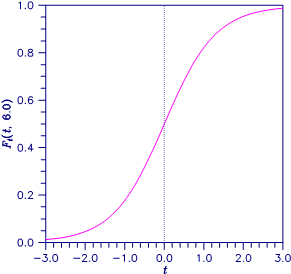Evaluates the Student's t distribution function.
Synopsis
#include <imsls.h>
float imsls_f_t_cdf (float t, float df)
The type double function is imsls_d_t_cdf.
Required Arguments
float t
(Input)
Argument for which the Student's t distribution function is to
be evaluated.
float df
(Input)
Degrees of freedom. Argument df must be greater
than or equal to 1.0.
Return Value
The probability that a Student's t random variable takes a value less than or equal to the input t.
Description
Function imsls_f_t_cdf evaluates the distribution function of a Student's t random variable with ν = df degrees of freedom. If the square of t is greater than or equal to ν, the relationship of a t to an F random variable (and subsequently, to a beta random variable) is exploited, and percentage points from a beta distribution are used. Otherwise, the method described by Hill (1970) is used. If ν is not an integer, is greater than 19, or is greater than 200, a Cornish- Fisher expansion is used to evaluate the distribution function. If ν is less than 20 and |t| is less than 2.0, a trigonometric series is used (see Abramowitz and Stegun 1964, Equations 26.7.3 and 26.7.4 with some rearrangement). For the remaining cases, a series given by Hill (1970) that converges well for large values of t is used.
Figure 11-8 Plot of Ft (t, 6.0)
Example
This example finds the probability that a t random variable with 6 degrees of freedom is greater in absolute value than 2.447. The fact that t is symmetric about 0 is used.
#include <imsls.h>
int main ()
{
float p;
float t = 2.447;
float df = 6.0;
p = 2.0*imsls_f_t_cdf(-t,df);
printf("Pr(|t(6)| > 2.447) = %6.4f\n", p);
}
Output
Pr(|t(6)| > 2.447) = 0.0500
|
Visual Numerics, Inc. PHONE: 713.784.3131 FAX:713.781.9260 |
